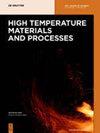High-temperature corrosion model of Incoloy 800H alloy connected with Ni-201 in MgCl2–KCl heat transfer fluid
IF 1.5
4区 材料科学
Q4 MATERIALS SCIENCE, MULTIDISCIPLINARY
引用次数: 0
Abstract
Abstract Long-term dipping corrosion experiments on Incoloy 800H (800H) in molten eutectic MgCl 2 –KCl salt at 1,073 K with and without connection with Ni-201 alloy were carried out. While connecting with Ni-201 alloy, the corrosion rate of 800H was 4.47 ± 0.26 mg·cm −2 ·day −1 (10 −3.55±0.02 A·cm −2 ). However, the corrosion rate for the 800H that was not connected to the Ni-201 alloy was 3.00 ± 0.27 mg·cm −2 ·day −1 (10 −3.71±0.04 A·cm −2 ). Therefore, Ni-201 alloy accelerates the corrosion rate of 800H in the molten MgCl 2 –KCl salt while connecting to each other. In addition, based on the calculation of Gibbs energy of Ni–Fe–Cr alloy and exchange current density of 800H in MgCl 2 –KCl salt, a new Tafel model was developed to predict the corrosion rate of 800H alloys. The corrosion rate calculated by the new model is 10 −3.74 A·cm −2 , which agrees with the experimental data.Ni-201连接incoly 800H合金在MgCl2-KCl传热流体中的高温腐蚀模型
摘要:在1073 K共晶mgcl2 -KCl熔盐中,对incoly 800H (800H)进行了与Ni-201合金连接和不连接的长期浸渍腐蚀实验。与Ni-201合金连接时,800H腐蚀速率为4.47±0.26 mg·cm−2·day−1(10−3.55±0.02 A·cm−2)。而未连接Ni-201合金的800H的腐蚀速率为3.00±0.27 mg·cm−2·day−1(10−3.71±0.04 A·cm−2)。因此,Ni-201合金在相互连接的同时,加速了800H在熔融MgCl 2 -KCl盐中的腐蚀速率。此外,通过计算Ni-Fe-Cr合金的吉布斯能和800H在MgCl 2 -KCl盐中的交换电流密度,建立了预测800H合金腐蚀速率的Tafel模型。模型计算的腐蚀速率为10 ~ 3.74 A·cm−2,与实验数据吻合较好。
本文章由计算机程序翻译,如有差异,请以英文原文为准。
求助全文
约1分钟内获得全文
求助全文
来源期刊

High Temperature Materials and Processes
工程技术-材料科学:综合
CiteScore
2.50
自引率
0.00%
发文量
42
审稿时长
3.9 months
期刊介绍:
High Temperature Materials and Processes offers an international publication forum for new ideas, insights and results related to high-temperature materials and processes in science and technology. The journal publishes original research papers and short communications addressing topics at the forefront of high-temperature materials research including processing of various materials at high temperatures. Occasionally, reviews of a specific topic are included. The journal also publishes special issues featuring ongoing research programs as well as symposia of high-temperature materials and processes, and other related research activities.
Emphasis is placed on the multi-disciplinary nature of high-temperature materials and processes for various materials in a variety of states. Such a nature of the journal will help readers who wish to become acquainted with related subjects by obtaining information of various aspects of high-temperature materials research. The increasing spread of information on these subjects will also help to shed light on relevant topics of high-temperature materials and processes outside of readers’ own core specialties.
 求助内容:
求助内容: 应助结果提醒方式:
应助结果提醒方式:


